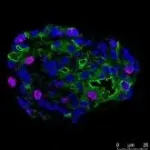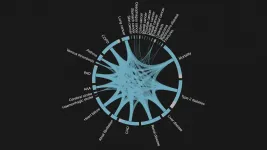A new model predicts snakebites to save human lives
Tel Aviv University participates in international study
2021-03-11
(Press-News.org) About 1.8 million envenoming snakebites occur around the world annually, killing about 94,000 people. In tropical areas, especially in Southeast Asia and Sub-Saharan Africa, snakebites are considered a major cause of death, especially among farmers who encounter snakes in their fields. In response, the World Health Organization has launched a strategic plan to reduce snakebites by 50% by 2030. An important basis for attaining this goal is expanding relevant scientific research.
An international research group, including researchers from Tel Aviv University, has recently created an innovative simulation model for predicting snakebites, based on an improved understanding of interactions between farmers and snakes, in both time and space.
The purpose of the model is to determine the probability of a snakebites occurring in certain places (for example in rice fields vs. tea fields) at various times (hours of the day and months of the year). The study is founded upon extensive research and data from Sri Lanka, where about 30,000 envenoming snakebites kill approximately 400 people every year. It focused on 6 types of snakes, some numbered among the most venomous in the world (cobra, Russell's viper, saw-scaled viper, hump-nosed viper, common krait and Ceylon krait), matching them with farmers who grow the three most common crops in the area: rice, tea and rubber. Thus for example, the model predicts that the bites of Russell's viper peak in rice fields during February and August, while the hump-nosed viper prefers rubber plantations in April and May. The model also determines that in the southeastern part of the studied region, the largest number of snakebites are inflicted by Russell's viper, one of the world's most dangerous snakes, while in other parts of this area snakebites of the less lethal hump-nosed viper are the most common.
The study was led by Dr. Takuya Iwamura (currently at Oregon State University) and Eyal Goldstein of the School of Zoology at Tel Aviv University, and Dr. Kris Murray of Imperial College London and the School of Hygiene and Tropical Medicine in London. Other participants included researchers from the Liverpool School of Tropical Medicine, Lancaster University and the University of Kelaniya, Sri Lanka. The paper was published in February 2021 in PLOS Neglected Tropical Diseases.
Eyal Goldstein explains: "We built a first-of-its-kind interdisciplinary model, which includes the behavior patterns of both sides - snakes and humans, identifying risk factors at various times and places, and warning against them. For example, the model can differentiate between low-risk and high-risk areas, a difference that can be manifested in double the number of snakebites per 100,000 people."
Dr. Murray explains that "Both snakes and people go about their business at different times of the day, in different seasons and in different types of habitats - the model captures all of this to predict encounters between people and snakes in areas where farmers are working. We then factor in the aggressiveness of different snake species to work out how likely an encounter is to result in a bite."
Dr. Iwamura emphasizes that "Our approach is to mathematically analyze interactions between snakes and humans, with an emphasis on the ecological perspective. This is a completely new approach to understanding the mechanism that causes snakebites. Unlike most studies, which have so far focused mainly on social and economic risk factors, we chose to focus on the ecological aspects - such as snakes' movements and habitats, the impact of climate and rainfall, and the respective behaviors of farmers and snakes - as a key to predicting potential encounters."
Verified against existing data in Sri Lanka , the model was proved very accurate in predicting snakebite patterns in different areas and different seasons, as well as the relative contribution of various types of snakes to the overall picture as seen in hospital data. Now the researchers intend to implement the model in places that don't yet have accurate snakebite data. They will and also use it to predict future changes resulting from climate change - such as increased rainfall leading to greater snake activity, as well as changes in land use and habitats available to snakes.
Dr. Iwamura concludes: "Our model can help focus the efforts of snakebite reduction policies, and serve as a tool for warning, raising awareness and saving human lives. Moreover, we regard this study as a first stage in a broader project. In the future we intend to develop more complex models of encounters between humans and wildlife, to support both public health and nature preservation policies in the real world."
INFORMATION:
[Attachments] See images for this press release:

ELSE PRESS RELEASES FROM THIS DATE:
2021-03-11
A rare disease first identified in 2020 is much more common than first thought, say researchers at the University of Leeds investigating its origins.
VEXAS syndrome is a serious inflammatory condition which develops in men over 50, causing them to become very sick and fatigued, and can be fatal. It was originally thought to be rare, but a new study has identified genetic mutations which indicate that the disease is actually much more common.
The researchers developed a genetic test to identify patients who may have the disease, and now want to screen more people showing symptoms to understand exactly how common it is.
VEXAS syndrome causes unexplained fevers, painful skin rashes and affects the bone ...
2021-03-11
The conditions on Earth are ideal for life. Most places on our planet are neither too hot nor too cold and offer liquid water. These and other requirements for life, however, delicately depend on the right composition of the atmosphere. Too little or too much of certain gases - like carbon dioxide - and Earth could become a ball of ice or turn into a pressure cooker. When scientists look for potentially habitable planets, a key component is therefore their atmosphere.
Sometimes, that atmosphere is primitive and largely consists of the gases that were around when the planet formed - as is the case for Jupiter and Saturn. On terrestrial planets like Mars, Venus or Earth, however, such primitive atmospheres are lost. Instead, their remaining atmospheres are strongly influenced ...
2021-03-11
COLUMBUS, Ohio - Electric stimulation may be able to help blood vessels carry white blood cells and oxygen to wounds, speeding healing, a new study suggests.
The study, published in the Royal Society of Chemistry journal Lab on a Chip, found that steady electrical stimulation generates increased permeability across blood vessels, providing new insight into the ways new blood vessels might grow.
The electrical stimulation provided a constant voltage with an accompanying electric current in the presence of fluid flow. The findings indicate that stimulation increases ...
2021-03-11
Grass pollen is a major outdoor allergen, responsible for widespread and costly respiratory conditions including allergic asthma and hay fever (rhinitis). Now, researchers re-porting in the journal Current Biology on March 11 suggest that environmental DNA could help to better understand which grasses are the worst offenders.
"These findings represent a first step towards changing and improving our understanding of the complex relationships between pollen and population health," said Benedict Wheeler of the University of Exeter, UK. "If confirmed and refined, this research could help to improve pollen forecasts and warnings in the future, supporting individual and community-level prevention strategies and management ...
2021-03-11
Hormones produced by the thyroid gland are essential regulators of organ function. The absence of these hormones either through thyroid dysfunction due to, for example, irradiation, thyroid cancer or autoimmune disease or thyroidectomy leads to symptoms like fatigue, feeling cold, constipation, and weight gain. The condition called hypothyroidism is estimated to affect up to 11% of the global population. Although hypothyroidism can be treated by hormone replacement therapy, some patients have persistent symptoms and/or experience side effects. To investigate potential alternative treatment strategies for these patients, researchers have now for the first time succeeded in generating thyroid mini-organs in the lab. In a END ...
2021-03-11
People often choose the standard option. Choosing to be an organ donor, printing on both sides of the page - such decisions are influenced by which is the standard setting, or default. In fact, economists and sociologists call this the default effect. Researchers at ETH Zurich and the University of Warwick in the UK have now managed to clearly demonstrate this effect. Private households, but also self-employed people and SMEs, are more likely to procure sustainably produced electricity if that is their provider's default offer.
The scientists conclude this from an analysis of data from two Swiss electricity suppliers - one large and one medium-sized. ...
2021-03-11
Researchers studying the Swiss energy market have found that making green energy the default option for consumers leads to an enduring shift to renewables and thus has the potential to cut CO2 emissions by millions of tonnes.
The study, published today in Nature Human Behaviour, investigated the effect of changes in the Swiss energy market that presented energy from renewable sources as the standard option for consumers - the 'green default.'
Both business and private customers largely accepted the default option, even though it was slightly more expensive, and the switch to green sources proved a lasting one.
Professor Ulf Liebe (University of Warwick), Doctor Jennifer Gewinner and Professor em. Andreas Diekmann (both ETH Zurich) analysed data from two Swiss ...
2021-03-11
New research, which brings healthcare data together with ground-breaking ecological techniques, could set a roadmap for refining pollen forecasts in the future.
Current pollen forecasts, crucial for people with allergic asthma or hay fever to manage their symptoms, rely on measuring the total load of grass pollen in the atmosphere. However, these do not distinguish between pollen from different types of grass.
Now, a potential link between pollen from certain grass species and respiratory health issues has been revealed.
The results, published in Current Biology, (11.3.21DOI: 10.1016/j.cub.2021.02.019 ) have been produced by the first project to use an ecological biomonitoring ...
2021-03-11
A new study published today in Nature Medicine has identified key risk factors that increase the likelihood of individuals developing not only one but multiple non-communicable diseases, which include cardiovascular disease, cancer, chronic respiratory disease and diabetes.
The analysis of over 11,000 people found that rather than being due to chance, there are often underlying biological links in individuals with multimorbidity, which is defined as the co-occurrence of two or more long-term health conditions and is a growing public health challenge.
Multimorbidity, which affects about two thirds of people aged 65 years or over in the UK, impairs an individual's quality of life over and above the cumulative burden from each individual disease. Understanding which diseases ...
2021-03-11
A national screening programme targeted at those men who are genetically pre-disposed to prostate cancer, and involving a blood test and MRI scan before an invasive biopsy, could prevent one in six prostate cancer deaths and significantly reduce over-diagnosis, finds a new study led by UCL researchers.
Prostate cancer is the most common form of cancer in men with around 130 new cases diagnosed in the UK every day and more than 10,000 men a year dying as a result of the disease. However, unlike breast and cervical cancer there is currently no national screening programme for this disease in the UK.
Currently, men suspected of having prostate cancer have a blood test that detects raised levels of the prostate-specific antigen (PSA)*. Following the UCL-led ...
LAST 30 PRESS RELEASES:
[Press-News.org] A new model predicts snakebites to save human lives
Tel Aviv University participates in international study




